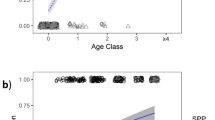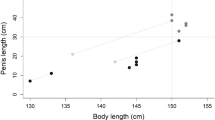Abstract
The reproductive biology of the fanray, Platyrhina sinensis, was examined in Ariake Bay, Japan, from May 2002 until December 2006. Females reached sexual maturity at a larger size than males [total length (TL) at 50% sexual maturity: male, 393 mm; female, 421 mm]. The present data support a distinct annual reproductive cycle for P. sinensis. The gonadosomatic index (GSI) for mature males showed a clear seasonal trend, declining from August to November. Histological observations showed that mature sperm in the testes occurred from August to November when monthly GSI declined. Concomitantly, pre-ovulatory ova were observed in females collected from August to November. These data indicate that mating, ovulation and fertilization occurred from August to November. Near-term embryos, neonates and recent post-partum females also occurred from August to November. Additionally, all post-partum females possessed large pre-ovulatory ova. Parturition occurred from August to November followed immediately by mating, ovulation and fertilization. Mature females become pregnant every year, and the gestation period is almost 1 year. Fertilized uterine eggs without macroscopic embryonic development were present throughout the annual reproductive cycle, indicating that P. sinensis utilizes embryonic diapause as its reproductive strategy. Both reproductive tracts of females were functional, and fecundity ranged from 1 to 12 with a mean of 6.0, increasing with TL.











Similar content being viewed by others
References
Braccini JM, Chiaramonte GE (2002) Reproductive biology of Psammobatis extenta. J Fish Biol 61:272–288
Compagno LJV (2005) Checklist of living Chondrichthyes. In: Hamlett WC (ed) Reproductive biology and phylogeny of Chondrichthyes: sharks, skates and rays. Science Publishers, Enfield, pp 503–548
Conrath CL, Musick JA (2002) Reproductive biology of the smooth dogfish, Mustelus canis, in the northwest Atlantic Ocean. Environ Biol Fish 64:367–377
Hatooka K (2000) Platyrhinidae. In: Nakabo T (ed) Fishes of Japan with pictorial keys to the species. Tokai University Press, Tokyo, p 161
Hirai Y, Nishinokubi H (2003) Actual conditions of discards of by-catch from small-scale trawl fishery in Ariake Sea. Nippon Suisan Gakkaishi 69:330–336
Ismen A, Yigin C, Ismen P (2007) Age, growth, reproductive biology and feed of the common guitarfish (Rhinobatos rhinobatos Linnaeus, 1758) in İskenderun Bay, the eastern Mediterranean Sea. Fish Res 84:263–269
Kume G, Furumitsu K, Yamaguchi A (2008) Age, growth and age at sexual maturity of the fanray, Platyrhina sinensis, (Batoidea: Platyrhinidae) in Ariake Bay, Japan. Fish Sci (in press)
Kyne PM, Bennett MB (2002) Reproductive biology of the shovelnose ray, Aptychotrema rostrata (Shaw & Nodder, 1794), from Moreton Bay, Queensland, Australia. Mar Freshw Res 53:583–589
Márquez-Farías JF (2007) Reproductive biology of shovelnose guitarfish Rhinobatos productus from the eastern Gulf of California México. Mar Biol 151:1445–1454
Marshall LJ, White WT, Potter IC (2007) Reproductive biology and diet of the southern fiddler ray, Trygonorrhina fasciata (Batoidea: Rhinobatidae), an important trawl bycatch species. Mar Freshw Res 58:104–115
Snelson FF Jr, Williams-Hooper SE, Schmid TH (1989) Biology of the bluntnose stingray, Dasyatis sayi, in Florida coastal lagoons. Bull Mar Sci 45:15–25
Wada T, Mitsunaga M, Suzuki H, Yamashita Y, Tanaka M (2006) Growth and habitat of spotted halibut Verasper variegatus in the shallow coastal nursery area, Shimabara Peninsula in Ariake Bay, Japan. Fish Sci 72:603–611
Wenbin Z, Shuyuan Q (1993) Reproductive biology of the guitarfish, Rhinobatos hynnicephalus. Environ Biol Fish 38:81–93
White WT, Hall NG, Potter IC (2002) Reproductive biology and growth during pre- and postnatal life of Trygonoptera personata and T. mucosa (Batoidea: Urolophidae). Mar Biol 140:699–712
Yamaguchi A (2003) Batoid species in Ariake Bay: feeding damage on bivalves. Kaiyo Monthly 35:241–245
Yamaguchi A, Taniuchi T, Shimizu M (1997) Reproductive biology of the starspotted dogfish Mustelus manazo from Tokyo Bay, Japan. Fish Sci 63:918–922
Yamaguchi A, Taniuchi T, Shimizu M (2000) Geographic variations in reproductive parameters of the starspotted dogfish, Mustelus manazo, from five localities in Japan and in Taiwan. Environ Biol Fish 57:221–233
Acknowledgments
We express sincere thanks to Seinosuke Yoshida and the commercial fishermen of the Shimabara Fisheries Cooperative Association. We also thank Jen Wyffels for English proofreading of this paper and two anonymous referees for their critical comments. This study was supported financially by Japan Science and Technology Corporation (JST).
Author information
Authors and Affiliations
Corresponding author
About this article
Cite this article
Yamaguchi, A., Kume, G. Reproductive biology of the fanray, Platyrhina sinensis (Batoidea: Platyrhinidae) in Ariake Bay, Japan. Ichthyol Res 56, 133–139 (2009). https://doi.org/10.1007/s10228-008-0078-6
Received:
Revised:
Accepted:
Published:
Issue Date:
DOI: https://doi.org/10.1007/s10228-008-0078-6




